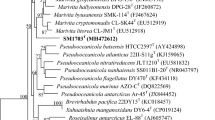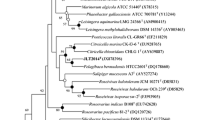Abstract
The alphaproteobacterial strain JLT2003T was isolated from surface seawater off the coast of Guishan island, Taiwan. The strain was Gram negative, ovoid or coccoid, non-motile and formed pink colonies on marine agar 2216 (MA; DIFCO) medium. The dominant fatty acids were C18:1ω7c, cyclo C19:0ω8c, and C16:0. The polar lipid profile consisted of diphosphatidylglycerol and phosphatidylglycerol. The major respiratory ubiquinone was Q-10. The DNA G+C content was 62.3 mol%. Phylogenetic analysis based on 16S rRNA gene sequences showed that the strain was most closely related to Pontibaca methylaminivorans GRP21T with 94.8% similarity. The isolate was distinguishable from members of the family Rhodobacteraceae based on phenotypic and biochemical characteristics. On the basis of the taxonomic data presented, strain JLT2003T is considered to represent a novel species of a new genus, for which the name Oceaniovalibus guishaninsula gen. nov., sp. nov. is proposed. The type strain of Oceaniovalibus guishaninsula is JLT2003T (=JCM 17765T = CGMCC 1.10827T).



Similar content being viewed by others
References
Andrews JM (2008) BSAC standardized disc susceptibility testing method (Version 7). J Antimicrob Chemother 62:256–278
Barritt MM (1936) The intensification of the Voges–Proskauer reaction by the addition of a-naphthol. J Pathol Bacteriol 42:441–445
Choi DH, Cho JC, Lanoil BD, Giovannoni SJ, Cho BC (2007) Maribius salinus gen. nov., sp. nov., isolated from a solar saltern and Maribius pelagius sp. nov., cultured from the Sargasso Sea, belonging to the Roseobacter clade. Int J Syst Evol Microbiol 57:270–275
Chu JN, Arun AB, Chen WM, Chou JH, Shen FT, Rekha PD, Kämpfer P, Young LS, Lin LS, Young CC (2010) Agaricicola taiwanensis gen. nov., sp. nov., an alphaproteobacterium isolated from the edible mushroom Agaricus blazei. Int J Syst Evol Microbiol 60:2032–2035
Clarke PH (1953) Hydrogen sulphide production by bacteria. J Gen Microbiol 8:397–407
Collins MD, Goodfellow M, Minnikin DE (1980) Fatty acid isoprenoid quinine and polar lipid composition in the classification of Curtobacterium and related taxa. J Gen Microbiol 118(1):29–37
Cowan ST, Steel KJ (1965) Manual for the identification of medical bacteria. Cambridge University Press, London
Dong XZ, Cai MY (2001) Determinative manual for routine bacteriology. Scientific Press, Beijing
Embley TM (1991) The linear PCR reaction: a simple and robust method for sequencing amplified rRNA genes. Lett Appl Microbiol 13:171–174
Fraser SL, Jorgensen JH (1997) Reappraisal of the antimicrobial susceptibilities of Chryseobacterium and Flavobacterium species and methods for reliable susceptibility testing. Antimicrob Agents Chemother 41:2738–2741
Garland JL (1996) Patterns of potential C source utilization by rhizosphere communities. Soil Biol Biochem 28:223–230
Garrity GM, Bell JA, Lilburn T (2005) Family I. Rhodobacteraceae fam. nov. In: Brenner DJ, Krieg NR, Staley JT, Garrity GM (eds) Bergey’s manual of systematic bacteriology, vol 2C, 2nd edn. Springer, New York, p 161
Gerhardt P, Murray RGE, Wood WA, Krieg NR (eds) (1994) Methods for general and molecular bacteriology. American Society for Microbiology, Washington, DC
Hall TA (1999) BioEdit: a user-friendly biological sequence alignment editor and analysis program for Windows 95/98/NT. Nucleic Acids Symp Ser 41:95–98
Harwati TU, Kasai Y, Kodama Y, Susilaningsih D, Kasai Y (2008) Tranquillimonas alkanivorans gen. nov., sp. nov.,an alkane-degrading bacterium isolated from Semarang Port in Indonesia. Int J Syst Evol Microbiol 58:2118–2121
Hiraishi A, Ueda Y, Ishihara J (1998) Quinone profiling of bacterial communities in natural and synthetic sewage activated sludge for enhanced phosphate removal. Appl Environ Microbiol 64:992–998
Ivanova EP, Webb H, Christen R, Zhukova NV, Kurilenko VV, Kalinovskaya NI, Crawford RJ (2010) Celeribacter neptunius gen. nov., sp. nov., a new member of the class Alphaproteobacteria. Int J Syst Evol Microbiol 60:1620–1625
Johnson JL (1994) Similarity analysis of DNAs. In: Gerhardt P, Murray RGE, Wood WA, Krieg NR (eds) Method for general and molecular Bacteriology. American Society for Microbiology press, Washington, DC, pp 655–681
Kim JM, Jung JY, Chae HB, Park W, Jeon CO (2010) Hwanghaeicola aestuarii gen. nov., sp. nov., a moderately halophilic bacterium isolated from a tidal flat of the Yellow Sea. Int J Syst Evol Microbiol 60:2877–2881
Kim KK, Lee JS, Lee KC, OH HM, Kim SG (2010) Pontibaca methylaminivorans gen. nov., sp. nov., a member of the family Rhodobacteraceae. Int J Syst Evol Microbiol 60:2170–2175
Komagata K, Suzuki K (1987) Lipid and cell-wall analysis in bacterial systematics. Methods Microbiol 19:161–207
Kumar S, Tamura K, Nei M (2004) MEGA3: integrated software for molecular evolutionary genetics analysis and sequence alignment. Bioinformatics 5:150–163
Lee K, Choo YJ, Giovannoni SJ, Cho JC (2007) Maritimibacter alkaliphilus gen. nov., sp. nov., a genome-sequenced marine bacterium of the Roseobacter clade in the order Rhodobacterales. Int J Syst Evol Microbiol 57:1653–1658
Leifson E (1963) Determination of carbohydrate metabolism of marine bacteria. J Bacteriol 85:1183–1184
Mandel M, Igambi L, Bergenda J, Dodson ML, Scheltge E (1970) Correlation of melting temperature and cesium chloride buoyant density of bacterial deoxyribonucleic acid. J Bacteriol 101:333–338
Mata JA, Martínez-Cánovas J, Quesada E, Béjar V (2002) A detailed phenotypic characterisation of the type strains of Halomonas species. Syst Appl Microbiol 25:360–375
Ostle AG, Holt JG (1982) Nile blue A as a fluorescent stain for poly-β-hydroxybutyrate. Appl Environ Microbiol 44:238–241
Pukall R, Buntefuss D, Frühling A, Rohde M, Kroppenstedt RM, Burghardt J, Lebaron P, Bernard L, Stackebrandt E (1999) Sulfitobacter mediterraneus sp. nov., a new sulfite-oxidizing member of the alpha-proteobacteria. Int J Syst Bacteriol 49:513–519
Rainey FA, Ward-Rainey N, Kroppenstedt RM, Stackebrandt E (1996) The genus Nocardiopsis represents a phylogenetically coherent taxon and a district actinomycete lineage: proposal of Nocardiopsaceae fam. nov. Int J Syst Bacteriol 46:1088–1092
Romano I, Lama L, Nicolaus B, Poli A, Gambacorta A, Giordano A (2006) Halomonas alkaliphila sp. nov., a novel halotolerant alkaliphilic bacterium isolated from a salt pool in Campania (Italy). J Gen Appl Microbiol 52:339–348
Smibert RM, Krieg NR (1994) Phenotypic characterization. In: Gerhardt P, Murray RGE, Wood WA, Krieg NR (eds) Methods for general and molecular microbiol. American Society for Microbiology, Washington, DC, pp 611–654
Ying JY, Wang BJ, Dai X, Yang SS, Liu SJ, Liu ZP (2007) Wenxinia marina gen. nov., sp. nov., a novel member of the Roseobacter clade isolated from oilfield sediments of the South China Sea. Int J Syst Evol Microbiol 57:1711–1716
Yoon JH, Kang SJ, Oh TK (2007) Donghicola eburneus gen. nov., sp. nov., isolated from seawater of the East Sea in Korea. Int J Syst Evol Microbiol 57:73–76
Yoon JH, Lee SY, Kang SJ, Lee CH, Oh TK (2007) Pseudoruegeria aquimaris gen. nov., sp. nov., isolated from seawater of the East Sea in Korea. Int J Syst Evol Microbiol 57:542–547
Yoon JH, Kang SJ, Jung YT, OH TK (2010) Gaetbulicola byunsanensis gen. nov., sp. nov., isolated from tidal flat sediment. Int J Syst Evol Microbiol 60:196–199
Yurkov VV, Krieger S, Stackebrandt E, Beatty JT (1999) Citromicrobium bathyomarinum, a novel aerobic bacterium isolated from deep-sea hydrothermal vent plume waters that contains photosynthetic pigment-protein complexes. J Bacteriol 181(15):4517–4525
Zheng Q, Chen C, Yan XJ, Wang YN, Zeng YH, Hao LK, He WH, Jiao NZ (2010) Mameliella alba gen. nov., sp. nov., a marine bacterium of the Roseobacter clade in the order Rhodobacterales. Int J Syst Evol Microbiol 60:953–957
Acknowledgments
The authors would like to thank Professor Henglin Cui, School of Food & Biological Engineering, Jiangsu University for his valuable help. This study was supported by the 973 program (2011CB808800), the NSFC project (91028001, 41076063), SOA project (201105021); MELRS0940.
Author information
Authors and Affiliations
Corresponding author
Additional information
The GenBank accession number for the 16S rRNA gene sequence of strain JLT2003T is HQ638975.
Rights and permissions
About this article
Cite this article
Liu, K., Zong, R., Li, Q. et al. Oceaniovalibus guishaninsula gen. nov., sp. nov., A Marine Bacterium of the Family Rhodobacteraceae . Curr Microbiol 64, 385–391 (2012). https://doi.org/10.1007/s00284-012-0081-z
Published:
Issue Date:
DOI: https://doi.org/10.1007/s00284-012-0081-z




